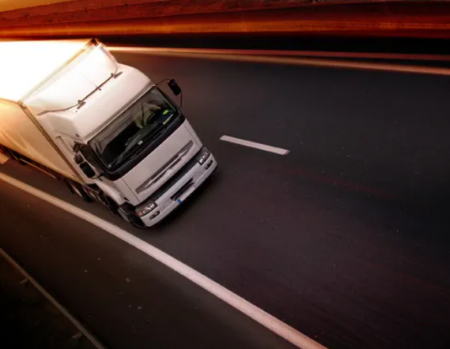Gordon Tutt of the Association of Freight Software Suppliers is given a tour ofthe Southampton Container Terminal to see how it is developing
At the start of January I had an opportunity to visit DP World and Community Network Services – CNS at the Southampton Container Terminal. Rob Freeman from DP World provided a tour of the Container Terminal and explained the processes and procedures being followed through the journey of the consignments in the terminal. It was fortunate that my visit was on one of the few dry days so far this year. Following the tour I visited the offices of CNS to meet the team and see how their system is used in the operation of the Container Terminal.
Like the other Community Service Providers in the UK, the operation of the CNS systems at the Container terminal at Southampton utilises the data provided by the shipper or Forwarder via their own software. Some of the processes within the Container Terminal rely heavily on the ability of this exchange of this data. AFSS members have a long association with the operations at the ports of Southampton and Felixstowe and the interface between trader systems and the Community System Provider (CSP) systems operated by CNS and MCP respectively. This is in addition to the other UK ports and airports operated by other CSPs such as CCS-UK and Pentant Ltd.
I should perhaps explain that my background is in air cargo and whilst I’ve had the opportunity to work closely with some of the
trade associations representing other modes of transport, I’m very much a novice when it comes to modes of transport outside the air cargo business.
Apart from a tour around the Port of Hamburg and a more recent visit to London Gateway this was my first opportunity to see a working sea port at close hand and look at the systems that are in place that manage and help the day to day running of the terminal and the consignments it handles.
The great thing about the logistics industry is the common factors that prevail despite the mode of transport and the size or scale of the operations. The recent purchase of four new cranes at Southampton demonstrates the extent of the need for ongoing investment within our industry.
The new cranes, worth £26 million, were in the final stages of completion when I visited the port and were near to being rolled into place at a new quay wall at Southampton. Each of the four 1,300-tonne, 126m- (413ft) high gantry cranes were built in Ireland and shipped in several parts for final assembly on site at Southampton. The final stage will involve them being moved 150m (492ft) to their operating location at the Western Docks using remote-controlled trailers.
This huge investment at Southampton will enable the port to handle the next generation of ultra-large container ships as they are able to reach across ships 24 containers wide. A fifth crane is due to be relocated from an existing berth in Southampton and will then complete the £150 million expansion of the terminal. The sight of the near completion was very impressive and this expansion helps secure the future of the container port of Southampton.
The introduction of the new generation of ultra large container ships is driven by the need for greater efficiencies by their operators. Significant cost savings can be achieved over the older and much smaller vessels. At certain speeds these larger ships have less fuel burn that those smaller vessels that they will replace.
It became very clear to me during my tour that the technology in place at Southampton also provides the means to keep the port efficient and competitive. This of course is common with facilities handling other modes of transport in the UK who are competing with handling facilities in other EU Member States.
There are an increasing number of containers that are moved from the Container Terminal to the rail facility where they are removed by freight trains to destinations throughout the UK. The increasing use of railways to transport sea containers has been brought about by improvements to the rail network and its ability to compete both in cost and speed of delivery with the road vehicle operators. During my visit last year to London Gateway it was evident that the rail links to this new terminal will play a large part in the future of this port and of the significant financial investment that was needed to bring about changes to the rail networks in this area of the country.
A recent assessment undertaken by the rail industry established the impact to the rail operations re-sulting from an anticipated increased to volume of traffic. Rail movements from not only Southampton but other deep sea ports are anticipated to grow progressively and plans are already in place to meet this growth.
There will not only be an increase of train operations out of Southampton but further efficiency meas-ures will be introduced to meet these demands. These will include train lengthening and improved utilisation with a six-day-a-week operation. Network Rail are undertaking enhancements and major improvements to the rail network throughout the UK to support the increase of traffic from UK ports. These improvements will significantly support the further development of intermodal freight capacity and capability throughout the country.
DP World at Southampton believe that the service levels they set for the unloading and loading of the vehicles to/from the container terminal are important to their customers. Maximising the utilisation and turn round of the vehicle provides a major benefit to all parties in the distribution chain. It also reduces the congestion within the port and the efficiency of operation for both the Container Terminal and the vehicle operators.
In keeping with other modes of transport the ocean carriers and port operators are using modernisation and new technology to deliver cost savings and greater efficiency to their business.
The operators of the vehicles used to deliver and collect cargo from the seaports and airports have also to introduce these savings in order to remain in business. Many UK companies have achieved efficiencies and remain competitive despite strong competition from companies in other European countries.
In a recent report compiled by The Centre for Sustainable Road Freight, a joint collaboration between Heriot-Watt and Cambridge Universities it was established that Road freight operators could save millions of pounds and significantly reduce carbon emissions by improving their operations. According to this research it is possible that industry could save £160 million in fuel and prevent 426,000 tonnes of carbon emissions from being released into the environment. This it reported is equivalent to the amount generated by approximately 70,000 cars a year.
Clearly this not only helps the environment but provides major savings in fuel and vehicle operating costs.
Many ports and airports have systems to process delivery and collections more efficiently. The systems introduced at Southampton have already seen significant support from their customers. AFSS members are working with ‘Dnata’ at Heathrow, who are due to introduce a new scheme for processing delivery and collections at their new Cargo Terminal. The scheme will require advanced electronic notification for all vehicles entering the terminal.
The more enlightened see that as an industry we must now strive to make further savings in the way we handle delivery and collections at our ports and airports. The Freight Software Suppliers have been working with both their customers, port operators and CSPs to provide the technology which can deliver these improvements.
With many customs and security procedures having already moved into the electronic age, the data that is currently used within these systems can be extended into new areas and could enable improvements to the handling of deliveries and collections which should then be able to work hand in glove.
The provision of electronic vehicle load lists is not new but where introduced gives the ports and their systems an ability to plan the handling of vehicles in advance and in a much more efficient manner. It can also provide the operators of the vehicle with the source of data to bring about improved planning and more cost effective use of their fleets. The increased utilisation of hand held mobile devices has brought the 21st century into the drivers cab. I predict that we will see further growth in this area in the future with the integration of the existing systems to these mobile devices.
AFSS members are in the forefront of the use of new technology including mobile technology. Software Providers continue to improve their systems with the objective of delivering further economies to their customers. The introduction of new technology helps to improve utilisation of vehicles and operations. This results in more efficient processing at the ports and airports. The savings that these systems provide are crucial in helping their customers remain competitive.







